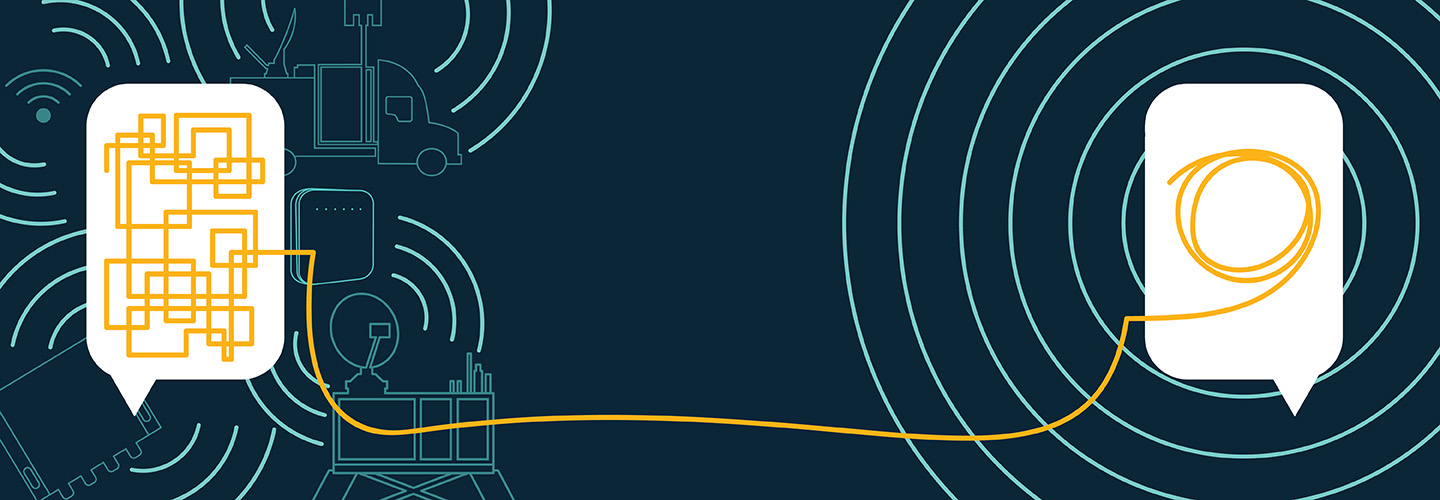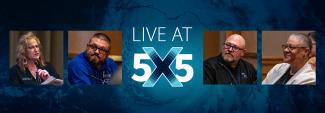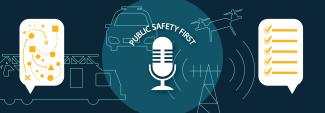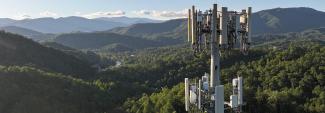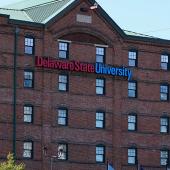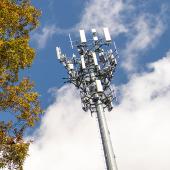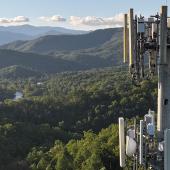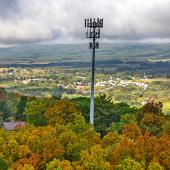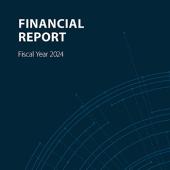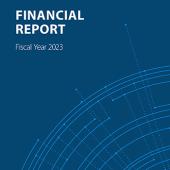Summary
Guest
Molly Hahn
Public Affairs Specialist, FirstNet Authority
Chuck Murph, Sr. Manager
Response and Event Operations, FirstNet Authority
Transcript
Preview
Narrator: You're listening to Public Safety First, a podcast to help you learn about the First Responder Network Authority and how you can be part of the future of public safety technology.
And now, your host.
Molly Hahn: Hello and welcome to another edition of ‘At its Core,’ the podcast here at the FirstNet Authority, where we detangle and demystify technical topics so that anyone can understand them. I am Molly Hahn, a public affairs specialist here at the FirstNet Authority, and I am joined by our expert here, Chuck Murph, to tell us all about what coverage means and how the FirstNet Authority can help public safety get more coverage, better coverage. Welcome, Chuck. Tell us about yourself and your role here at the FirstNet Authority.
Narrator: You're listening to Public Safety First, a podcast to help you learn about the First Responder Network Authority and how you can be part of the future of public safety technology.
And now, your host.
Molly Hahn: Hello and welcome to another edition of ‘At its Core,’ the podcast here at the FirstNet Authority, where we detangle and demystify technical topics so that anyone can understand them. I am Molly Hahn, a public affairs specialist here at the FirstNet Authority, and I am joined by our expert here, Chuck Murph, to tell us all about what coverage means and how the FirstNet Authority can help public safety get more coverage, better coverage. Welcome, Chuck. Tell us about yourself and your role here at the FirstNet Authority.
Chuck Murph: Absolutely. Thank you, Molly, for having me. I work with the public safety advocacy team in the FirstNet Authority. I work with a small team called the Stakeholder Collaboration Division within PSA. We specifically do targeted engagements with public safety and the public safety advocacy team. We really work very closely with our public safety partners out there to get out and engage with them in the field to really understand the needs they have for wireless broadband service, products, devices, solutions. So, our team works hand in hand with public safety to capture their feedback and make sure that it's actionable on our side of the fence, that we can take this information back to our partner, AT&T, and really inform our own selves as it relates to reinvestment in the nationwide public safety broadband network.
Molly Hahn: That's excellent. What are the things that you're hearing when you engage with public safety? What are the challenges that they're facing when it comes to coverage across this nation?
Chuck Murph: I want more of it and I want it everywhere. That's the big thing with public safety, there's places where FirstNet is looking at where there may not be population-based type coverage initiatives, or it may be more of a 9-1-1 call or a public safety demand-type area where it needs coverage. So, that's the reason it's so very important for us not to be, you know, just like any other carrier out there. We actually have to bring in the public safety perspective. So, you look at state parks, or national parks, or our very rural roadways, where there's just really not that much congestion on traditional terrestrial networks. But, there may be a high call volume for public safety assistance in that area. They're like, look, over the past 12 months we've had 13 calls out here for wrecks at this particular area, and we really need to have coverage here. So, those type things are really golden nuggets for us. When we start looking at how do we capture Public Safety's input on where they need coverage the most. And then how do we roll that into our reinvestment strategy here on the FirstNet Authority side, to work with our partner AT&T, to try to look at those type areas and bring coverage to those areas where it may not be a population determination, but it is definitely a public safety need in that particular area.
Molly Hahn: That's excellent. We talked with Brian Hobson on a previous episode about investments. We know that it's really Public Safety's voice that drives our investment and our choices there. What are some things that we've done with that to address these desires, to meet those needs for public safety?
Chuck Murph: So, we're working very hard to try to make sure that we get coverage in many places as we can, as we continue to reinvest in the network and we push coverage out there, it's just going to duplicate, and duplicate, duplicate more areas to where we can bring FirstNet to public safety in those areas where they need them the most. You know, it's a ten-year investment that we're looking at in partnership with public Safety, and what we're doing on our side of the fence on the authority to capture Public Safety's feedback is these coverage enhancements workshops that we're doing with public safety. I think ultimately that will be something that would really help to make sure that we've got as much coverage, feedback, data from public safety as possible to make those decisions with the reinvestment dollars that we'll be putting back into FirstNet.
Molly Hahn: I will say that I've heard a word that comes up and I'm always thinking, it's funny because it doesn't sound like a real word, but I've heard this word deployables, and I think that it's a good way, in my understanding, to boost coverage in the immediate, what's a deployable, Chuck? And how do I get some coverage right now?
Chuck Murph: Yeah, try topping that word into Microsoft Word. It'll let you know very quickly - it is not a word. But, it's very much a very important word to us here at the FirstNet Authority and to our FirstNet stakeholders out in the field. Deployables are solutions that can be rolled out on scene to Seeing to provide coverage where there's either no macro coverage or lost macro coverage, or it may be in an area where there was no coverage to begin with. Let's think about wildland firefighting. You know, they're out there in very wilderness type areas where there is no cellular coverage. So, these are solutions that can be rolled out that can provide, you know, temporary on the spot bubble-type coverage for public safety to execute their operations and be effective in communicating. So, you got SatCOLTs or SatCOWs. These are satellite trucks trailers that we can bring out there that gives coverage. You know, each deployable is different in the range of coverage it'll provide based on topography. You know, canopy, that type area. These are solutions that can come out there and provide five-miles coverage, two-miles coverage, half-mile type coverage.
Chuck Murph: And there's a number of different solutions out there. So, you know, the most popular by far is the SatCOW, SatCOLTs that we have. And then, we also have what we call CRDs, or our Compact Rapid Deployables. These are very small units that can be pulled, connected to a truck or a pickup, to a very wilderness area, steep terrain, mountainous terrain, that type of stuff. And give you very small bubble type coverage – mile, two miles, depending upon topography. Uh, and then line of sight to a satellite in the air. And then, we also have what we call a miniCRD. So, miniCRD is actually two cases. It has the same SBO, what we call a Single Band Operation radio mounted inside one of the cases. And then, in the other case it has a panel to provide LEO [Low Earth Orbit]-type connectivity back to the public safety core that really provides connectivity for public safety in a very small area. Our urban search and rescue teams love those type solutions because they're extremely portable, they're highly reliable and they provide the coverage they need whenever they're out there in very austere conditions trying to do their job.
Molly Hahn: One of the things you mentioned earlier that I'm curious about is that there are areas where there's just no coverage. Is there a solution for that? Is there something we can do if it's not even remotely near some sort of coverage area?
Chuck Murph: Yeah. So, one thing that that's been very popular as well is the COAM program that AT&T offers. So, if you're a jurisdiction who is a FirstNet customer and you have wilderness area that doesn't have typical macro coverage, then we have what we call a customer owned and maintained program that AT&T offers. So, you can actually go in and buy and own one of these compact rapid Deployables or a miniCRD that you can deploy when you need coverage. Right? So, you don't have to call the one 800 number, or you don't have to use the FirstNet app to request a deployable for your operations. You already own that equipment. You maintain that equipment. So, when you get ready for it, you deploy it with you in your operations. And it's been hugely successful. We've got a lot of great feedback from Public Safety who have purchased these deployable solutions and integrated them into their response apparatus. It's just been a very empowering tool for them to be able to bring to bear in these particular areas where they know before they even get there that there's really no coverage there.
Molly Hahn: That's a lot of options. Thanks for breaking those down a little bit from kind of the big to the small. One of the things I also think about, though, is what do you do if you don't have coverage indoors? You know, these sound like, great if I'm out in the search and rescue or wildfire, but what if I'm searching for something inside? What do I do?
Chuck Murph: Great question Molly. So, one of the most successful programs we've had as part of our reinvestment here at the FirstNet Authority thus far is our agency-deployed Ran program. So, this is a program that our leadership and our board of directors voted on a few years back to take reinvestment dollars from FirstNet and buy Cell Booster Pro solutions for public safety. And those public safety entities who are FirstNet subscribers get them free of charge as part of the FirstNet offering. It's just providing coverage in an office place for FirstNet subscribers. So, instead of the FirstNet phones that are operating in that building, having to rely on the Wi-Fi provided by that particular building, it actually is just like they walked in off the street with their devices into a new macro saturated environment to where their devices are affiliating to the FirstNet core, just like they would outside. So, it's a great capability to provide FirstNet subscribers the ability to seamlessly walk in off the street into their office and be able to have that data connectivity that they're dependent upon for FirstNet.
Molly Hahn: Sounds like it's pretty easy to set up, and it sounds like it's available to any FirstNet subscribing agency.
Chuck Murph: Yeah. So, if there's an agency out there who is interested in getting a Cell Booster Pro for your particular agency, please reach out to your FirstNet AT&T representative. They have all the information you need to begin the process of getting you signed up. Typically, we see these cover about 1500ft², you know, in a building. So, your FirstNet AT&T representative will help you determine how many of those you need to meet the coverage demand that you have for that particular office space.
Molly Hahn: That's excellent. I did a little bit of preparing for this podcast, and I heard about this thing called HPUE. What is HPUE? When would I use that kind of device.
Chuck Murph: Yeah. So, HPUE stands for High Power User Equipment. And it's something very unique to Band 14 and FirstNet. So, we have equipment that boosts the signal power up to six times a normal strength at the edge of the network. So, if you know that you need connectivity going down into these areas where there's very limited macro coverage, then you can use these HPUE solutions to provide you coverage further out. So, it extends the network for you out there to where you have public safety operations ongoing. We've had a lot of good feedback from public safety that's made the product better over the last few years, and it's really a testament to being able to listen to public safety who are in these unique coverage environments, to be able to tell us, okay, we need to change this part or we need to enhance this ability, or we need to take and be able to make this more portable or more sustainable when it's hooked to a particular router or modem that they're using in their particular operations. I would encourage any departments out there who are on those fringe areas, or if you struggle with coverage in your particular area, or if you have places in your jurisdiction that you know could be potential issues. Talk to your AT&T FirstNet representative about HPUE solutions to make a decision if it's right for you.
Molly Hahn: This is great. It sounds like there are some solutions right now that public safety can use to kind of boost their coverage. Is there a centralized way for requesting anything, or is it call out to your AT&T representative?
Chuck Murph: Yeah. Reach out to your AT&T representative. Make sure they understand what the need is. Let them come out and help inform you if you need this particular solution, or if there's another solution that may fit your need more favorably. You can always reach out to our senior public safety advisors that we have from the FirstNet Authority in the field. Just go to our website FirstNet.gov. Click on my state and it will tell you who is your particular representative from our Public Safety Advocacy team, and they will definitely be able to help you, walk you through the advantages and disadvantages.
Molly Hahn: This is great. And, I think you are underselling your team's role. How are we checking that we're hitting the mark as we keep rolling out these new things and reinvesting?
Chuck Murph: Yeah, absolutely. Great question. We are definitely continuing the conversation. You know, I think it's a cornerstone of the success of FirstNet as a whole, right, is the ability for the FirstNet Authority to bring that.gov to.gov relationship to bear. Most of our public safety advocacy team are prior public safety or our current public safety responders in their jurisdiction. So, they talk the lingo, they understand the lingo. They understand the difficulties that some of these jurisdictions face as it relates to connectivity. We have a lot of relationships we've built over the years. I can't talk enough about how valuable those relationships that are, uh, senior public safety advisors have built with public safety across the United States, how important that is, and really how it's going to help us in our reinvestment process as we move into more reinvestment discussions with public safety over the next few years.
Molly Hahn: Chuck, I'm grateful for having you help me learn what public safety needs. You have a wealth of experience and knowledge. I always love to know, what's your favorite story about a coverage solution, or sometime where you've received public safety feedback and it's made a difference in this process?
Chuck Murph: You know, I'll never forget the first time I saw the Compact Rapid Deployable. That was a game changer, in my opinion, for how we look at deployable coverage. Anytime you can condense it down to a trailer pulled or a case toting solution, it's really a game changer for how we plan and execute public safety operations in the field. It enhances public safety's ability to communicate greatly, and it reduces the amount of time that you can get that solution on air in service, serving public safety when they need it the most. I live down in Hurricane Alley, so, you know, every year we're always looking at potential tropical storm type events happening here. Looking back, Hurricane Ivan that hit the Gulf Coast in 2004 devastated the Mobile and Pensacola area. Of course, everybody knows Katrina that devastated New Orleans and Mississippi. If we would have had those type solutions back then, it would have been a game changer for getting into these local jurisdictions, or even part of the comb offering to where they own the equipment. They could have quickly took that equipment out in the open, got it set up operational after tropical storm force winds had died down, and instantly had connectivity back to the state EOC or to a regional EOC. And, I think you're seeing like after Hurricane Helene, people like State of Florida, they have CRDs that they go around with their state emergency response teams. They're figuring out pretty quick how to leverage these solutions in these very bad situations where communications are really down and out for the foreseeable future.
Molly Hahn: It's amazing how public safety, they're getting more prepared as things are becoming less predictable. And, it's a testament to all of the hard work of you and your team and public safety engaging with us. So again, thank you, Chuck. This has been incredibly informative. I really appreciate having you and I hope we keep this conversation going.
Chuck Murph: Great. Thank you for having us, Molly.
Narrator:Thanks for listening today. We're excited to have you join our podcast community. Make sure to subscribe on iTunes, SoundCloud, and YouTube. You can learn more about the First Responder Network Authority at FirstNet.gov and learn about FirstNet products and services at FirstNet.com.


